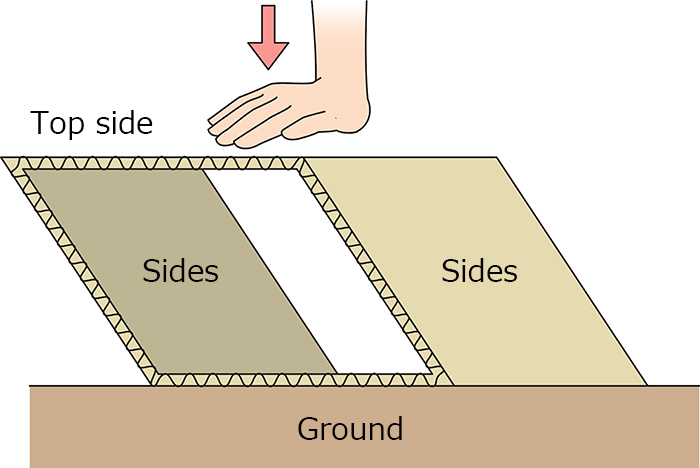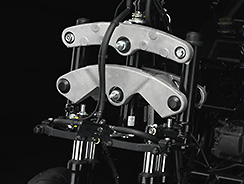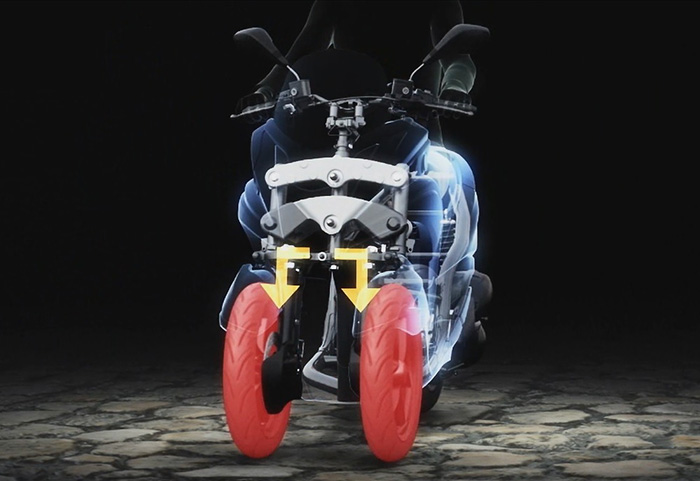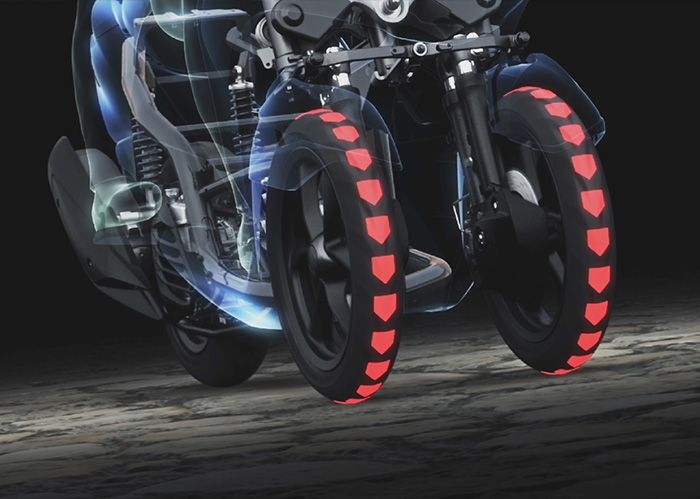The Origins of Yamaha’s LMW Technology? Chopsticks.
Introducing the stories behind Yamaha Motor's technologies.

With the Tricity 125, Yamaha’s first production Leaning Multi-Wheel (LMW) model, the core focus of the technology was giving it two front wheels. The Tricity uses a conventional scooter chassis for the rear part of the chassis and couples it with a two-wheeled structure for the front part of the chassis, making it an LMW vehicle.
But how does the front assembly lean? If this is a little hard to imagine, you can probably get a good idea of the dynamics involved by opening the top and bottom of a cardboard box, turning it on its side and then pushing down on it (#1). In this case, the right and left sides of the box represent the two front wheels and their suspensions, the top side represents the mechanism that connects the two front wheels and chassis, and the side on the bottom is the ground.
In fact, shortly after development of the Tricity began, Project Leader Kazuhisa Takano used two common household items to verify the basic workings for the two front wheels: disposable wooden chopsticks and rubber bands.
He broke the chopsticks into suitable lengths and aligned them vertically and horizontally, binding them together with rubber bands to make the structure flexible. By creating this 3D mock-up of the structure he had in mind, he was able to better confirm the validity of its design.
The Two Fundamental Mechanisms of the LMW Design
To achieve performance with a good feeling of agility, lightness and stability in a vehicle configuration with two front wheels and one rear wheel, the front assembly of the Tricity 125 employs independent right and left cantilevered telescopic suspensions that are supported and connected to the chassis by means of a parallelogram link mechanism (#2).
This system separates the mechanisms for allowing the two front wheels to lean and suspension functionality, and makes it possible to achieve both a deep lean angle and a large steering angle for the handlebars, which contribute to the Tricity’s light and agile feel.
Parallelogram Link: Producing Natural Lean Characteristics with a Good Feeling of Stability
By enabling the two front wheels to lean in concert with the chassis when turning, the LMW mechanism brings a natural feel to the handling. The essential component for achieving this is the parallelogram link (#3) mechanism that supports the left and right independent suspensions of the two front wheels and connects them to the chassis.
The link itself is composed of two arms that are always parallel to each other and are positioned one above the other. With the right and left suspensions connected to them, the link assembly takes the form of a rectangle when seen from the front with the vehicle upright and a parallelogram when the machine is leaning.
The basic construction of the parallelogram link is simple and enables a lighter and more compact unit. And, because there is little change in the width between the right and left tires where they contact the ground, it achieves natural handling qualities with a good feeling of stability.


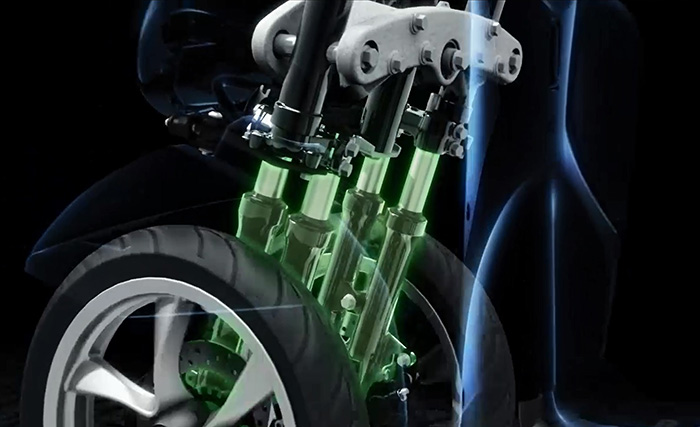
Cantilevered Telescopic Suspension: Contributing to Weight Reduction and More
For the front suspension, there was a choice between the telescopic type commonly used on conventional motorcycles and the bottom-link type used on some scooter models. Considering the balance between each type’s merits and demerits and the goal of achieving a natural feel to the ride, the telescopic type was chosen.
At first, using forks that straddle the wheels to hold the axles from both sides were under consideration, but from the perspective of design and other factors, it was decided to use cantilevered types (#4). The end result is the Tricity using two independent forks to hold the insides of the two front wheels in what is now one of the vehicle’s iconic design points. This structure not only enabled a lighter and slimmer chassis design, but it also proved to be the better choice for achieving the various functional qualities desired for an LMW vehicle.
Concerning the tubes on the two cantilevered forks for each wheel, the front-set tubes function as guides while the rear-set tubes handle shock-absorbing.
Differences between a Telescopic and Bottom-Link Suspension
Telescopic type
Most motorcycles use this type of suspension. Two tubes of different diameters slide up and down against each other like a telescope. Excessive compression can have a negative effect on machine attitude, but it is well-suited for mass production and has excellent reliability.
Bottom-link type
This type is used on some basic scooters and commercial/utility-use models. This type makes lightweight, low-cost designs possible, but dimension limitations make it difficult to get a large amount of suspension travel.
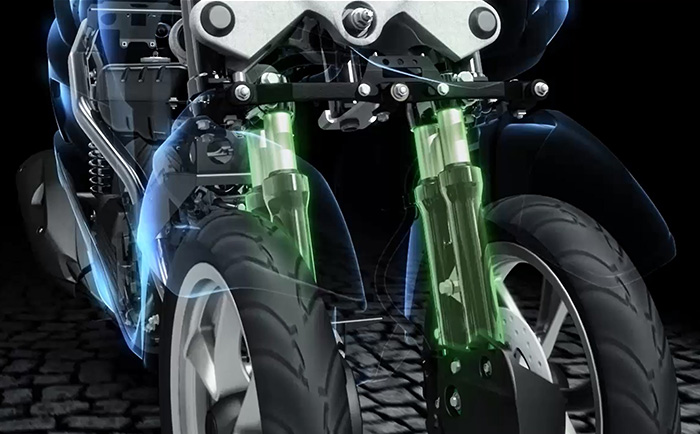

The Basic Idea is to Divide the Front Tire’s Heavy Workload
The twin-front wheel design of the Tricity divides the load placed on the front tire in a conventional layout and thus effectively reduces it. One of the main benefits of the LMW design is the confidence-inspiring feel and performance potential it brings, especially during cornering and braking (#5).
At the same time, by using Yamaha-exclusive technologies and meticulous fine-tuning to create a ride character as close as possible to a conventional motorcycle, the development team sought performance that could help more people enjoy the fun and exhilaration of leaning a machine through turns.
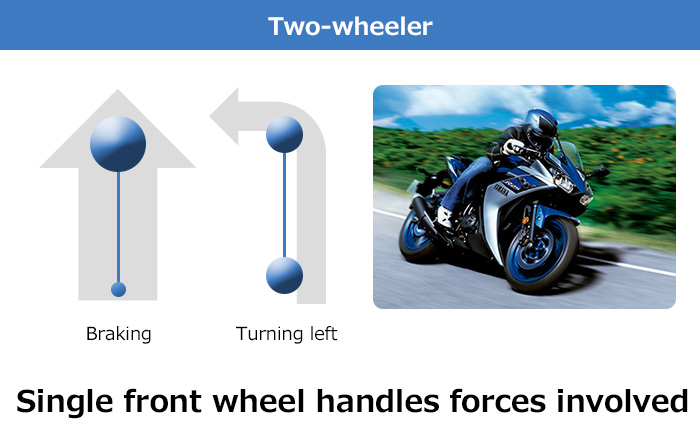

The Added Benefits LMWs Bring to Commuter Vehicles
Small and mid-sized scooters typically adopt a design that combines the rear suspension components and the engine into a single “unit-swing” structure, which tends to make the rear half of the chassis heavier. But with the Tricity 125, adopting a twin-front wheel configuration naturally made it possible to achieve a more ideal front-rear weight distribution.
Creating a chassis with a front-rear weight distribution similar to a MotoGP race machine (#6) provided a foundation that made it possible to develop a ride character that is both natural and sporty.
What Are Eight Benefits of the LMW Mechanism?
Yamaha LMW vehicles are intended to let more people than ever enjoy the fun unique to riding a motorcycle. Here is a brief look at the benefits they offer in different types of riding conditions.
Going over uneven surfaces (#7)
The independent suspensions for the two front wheels and the LMW mechanism function together, so that they work to absorb changes in the level of the road surface or shocks from the road.
Riding on cobblestones or rough roads (#8)
The independent suspensions for the two front wheels and the LMW mechanism function together, so that they work to absorb the shocks of cobblestone streets or rougher road surfaces well, thus providing a comfortable ride.
Riding over wet manhole covers, cobblestones, tram rails or sandy road surfaces (#9)
Even on slippery surfaces, if one of the LMW vehicle’s two front wheels (right or left) loses grip, as long as the other wheel maintains grip, the risk of a fall due to front-wheel slippage is reduced.
Cruising (#10)
An LMW vehicle provides light, agile and sporty handling, creating a confidence-inspired feeling of stability from the vehicle’s performance for a whole new kind of riding enjoyment.



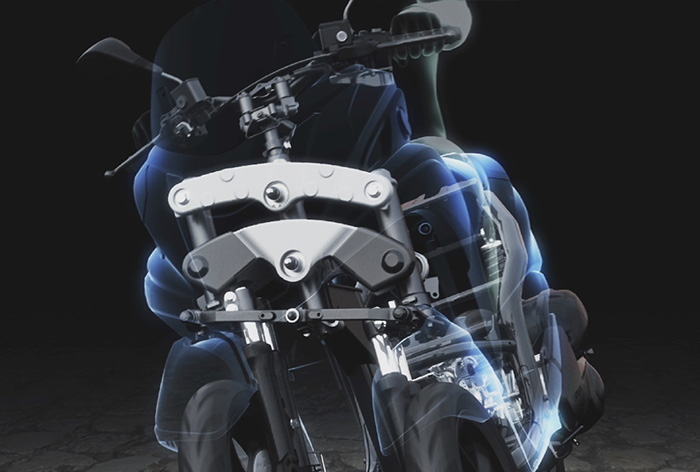
Cornering (#11)
Yamaha’s unique LMW mechanism enables the two front wheels to lean in unison with the chassis and follow contour changes in the road surface well, creating a clear feeling of stability. When turning or cornering even on slippery surfaces, if one of the LMW vehicle’s two front wheels (inner or outer) loses grip, as long as the other wheel maintains grip, the risk of a fall due to front-wheel slippage is reduced.
Braking (#12)
Even during straight-line hard braking, the front wheels on an LMW vehicle are difficult to lock up, thus reducing the risk of a fall due to front-wheel lock up. The two front wheels on an LMW vehicle provide excellent grip and can thus deliver stronger braking force.
In crosswinds (#13)
Even in sudden crosswinds, an LMW vehicle has little machine fluctuation because there are two front wheels, thus bringing the rider a clear feeling of stability.
Running at slow speeds (#14)
Because there are two front wheels, there is little machine fluctuation and a clear feeling of stability when riding at low speeds.
